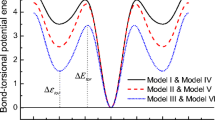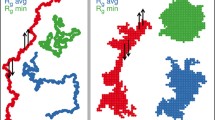Abstract
Over the last two decades generalized ensemble Monte Carlo computer simulation studies employing multicanonical, Wang–Landau, or replica-exchange methods have proven to be a strong numerical tool for investigations of the statistical physics of polymer chains.
After a discussion of the theoretical background of these approaches, their power will be demonstrated in two applications to coarse-grained models of semiflexible polymers, which show a rich variety of structural motifs such as hairpins, knots and twisted bundles.
Similar content being viewed by others
References
W. Janke and W. Paul, “Thermodynamics and structure of macromolecules from flat-histogram Monte Carlo simulations (invited review),” Soft Matter 12, 642–657 (2016).
J. Zierenberg, M. Marenz, and W. Janke, “Dilute semiflexible polymers with attraction: collapse, folding and aggregation (invited review),” Polymers 8, 333–1–19 (2016).
B. A. Berg and T. Neuhaus, “Multicanonical algorithms for first order phase transitions,” Phys. Lett. B 267, 249–253 (1991).
B. A. Berg and T. Neuhaus, “Multicanonical ensemble: a new approach to simulate first-order phase transitions,” Phys. Rev. Lett. 68, 9–12 (1992).
W. Janke, “Multicanonical simulation of the two-dimensional 7-state Potts model,” Int. J. Mod. Phys. C 03, 1137–1146 (1992).
W. Janke, “Multicanonical Monte Carlo simulations,” Physica A 254, 164–178 (1998).
K. Hukushima and K. Nemoto, “Exchange Monte Carlo method and application to spin glass simulations,” J. Phys. Soc. Jpn. 65, 1604–1608 (1996).
F. Wang and D. P. Landau, “Efficient, multiple-range random walk algorithm to calculate the density of states,” Phys. Rev. Lett. 86, 2050–2053 (2001).
F. Wang and D. P. Landau, “Determining the density of states for classical statistical models: a random walk algorithm to produce a flat histogram,” Phys. Rev. E 64, 056101−1–16 (2001).
J. Zierenberg, M. Marenz, and W. Janke, “Scaling properties of a parallel implementation of the multicanonical algorithm,” Comput. Phys. Commun. 184, 1155–1160 (2013).
J. Zierenberg, M. Marenz, and W. Janke, “Scaling properties of parallelized multicanonical simulations,” Phys. Proc. 53, 55–59 (2014).
J. Gross, J. Zierenberg, M. Weigel, and W. Janke, “Massively parallel multicanonical simulations,” arXiv:1707.00919 (2017).
E. Bittner and W. Janke, “Free-energy barriers in the Sherrington–Kirkpatrick model,” Europhys. Lett. 74, 195–201 (2006).
D. H. E. Gross, Microcanonical Thermodynamics (World Scientific, Singapore, 2001).
W. Janke, “Canonical versus microcanonical analysis of first-order phase transitions,” Nucl. Phys. B (Proc. Suppl. A-C) 63, 631–633 (1998).
C. Junghans, M. Bachmann, and W. Janke, “Microcanonical analyses of peptide aggregation processes,” Phys. Rev. Lett. 97, 218103−1–4 (2006).
S. Schnabel, D. T. Seaton, D. P. Landau, and M. Bachmann, “Microcanonical entropy inflection points: key to systematic understanding of transitions in finite systems,” Phys. Rev. E 84, 011127−1–4 (2011).
P. Schierz, J. Zierenberg, and W. Janke, “First-order phase transitions in the real microcanonical ensemble,” Phys. Rev. E 94, 021301−1–5(R) (2016).
J. Zierenberg, P. Schierz, and W. Janke, “Canonical free-energy barrier of particle and polymer cluster formation,” Nat. Commun. 8, 14546−1–7 (2017).
M. Marenz and W. Janke, “Effect of bending stiffness on a homopolymer inside a spherical cage,” Phys. Proc. 57, 53–57 (2014).
M. Marenz and W. Janke, “Knots as a topological order parameter for semiflexible polymers,” Phys. Rev. Lett. 116, 128301−1–6 (2016).
W. Janke and M. Marenz, “Stable knots in the phase diagram of semiflexible polymers: a topological order parameter?,” J. Phys.: Conf. Ser. 750, 012006−1–5 (2016).
D. T. Seaton, S. Schnabel, M. Bachmann, and D. P. Landau, “Effects of stiffness on short, semiflexible homopolymer chains,” Int. J. Mod. Phys. C 23, 1240004−1–7 (2012).
D. T. Seaton, S. Schnabel, D. P. Landau, and M. Bachmann, “From flexible to stiff: systematic analysis of structural phases for single semiflexible polymers,” Phys. Rev. Lett. 110, 028103−1–5 (2013).
P. Virnau, “Detection and visualization of physical knots in macromolecules,” Phys. Proc. 6, 117–125 (2010).
L. H. Kauffman,Knots and Physics, 2nd ed. (World Scientific, Singapore, 1991).
C. Junghans, M. Bachmann, and W. Janke, “Thermodynamics of peptide aggregation processes: an analysis from perspectives of three statistical ensembles,” J. Chem. Phys. 128, 085103−1–9 (2008).
C. Junghans, M. Bachmann, and W. Janke, “Statistical mechanics of aggregation and crystallization for semiflexible polymers,” Europhys. Lett. 87, 40002–1–5 (2009).
J. Zierenberg, M. Mueller, P. Schierz, M. Marenz, and W. Janke, “Aggregation of theta-polymers in spherical confinement,” J. Chem. Phys. 141, 114908−1–9 (2014).
M. Mueller, J. Zierenberg, M. Marenz, P. Schierz, and W. Janke, “Probing the effect of density on the aggregation temperature of semi-flexible polymers in spherical confinement,” Phys. Proc. 68, 95–99 (2015).
J. Zierenberg and W. Janke, “From amorphous aggregates to polymer bundles: the role of stiffness on structural phases in polymer aggregation,” Europhys. Lett. 109, 28002−1–6 (2015).
Author information
Authors and Affiliations
Corresponding author
Additional information
Submitted by L. N. Shchur
Rights and permissions
About this article
Cite this article
Janke, W., Marenz, M. & Zierenberg, J. Generalized ensemble computer simulations for structure formation of semiflexible polymers. Lobachevskii J Math 38, 978–985 (2017). https://doi.org/10.1134/S1995080217050171
Received:
Published:
Issue Date:
DOI: https://doi.org/10.1134/S1995080217050171




